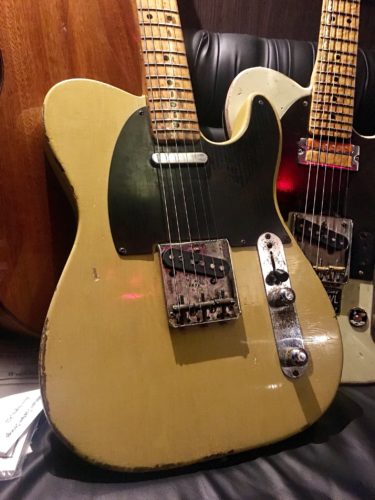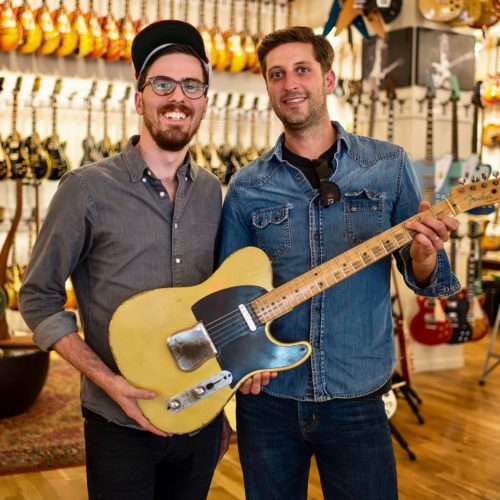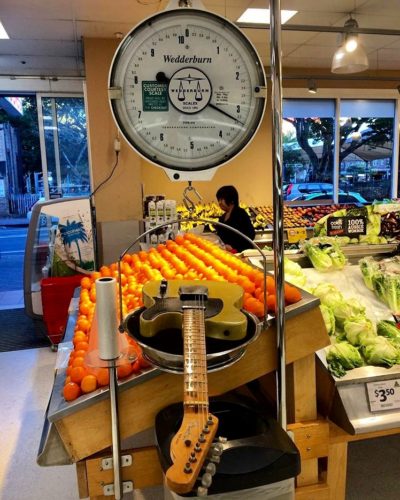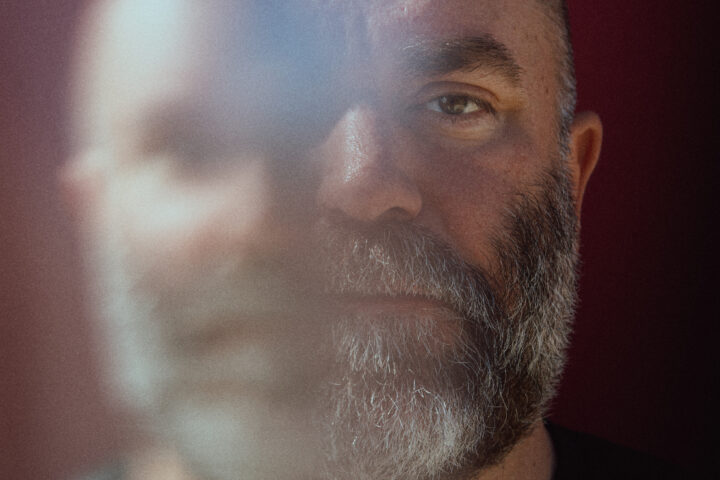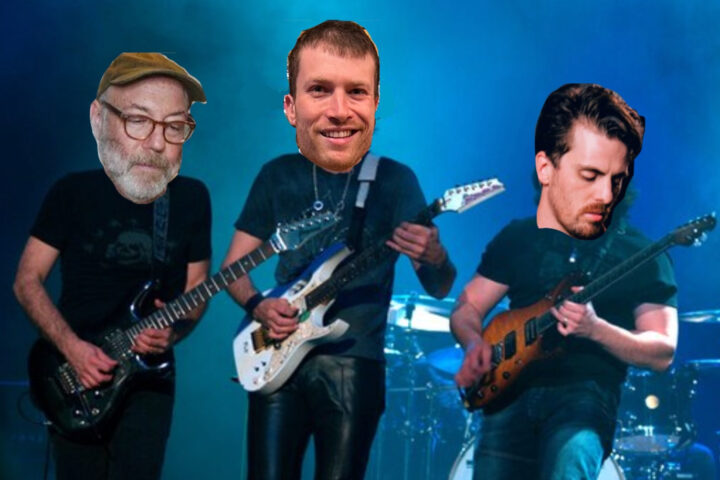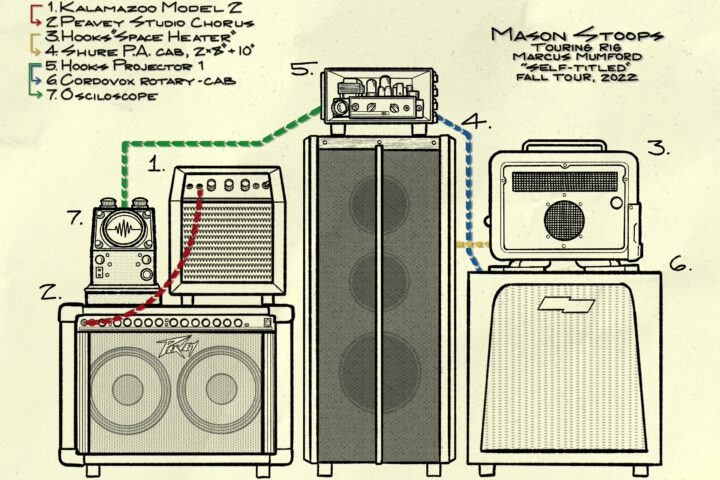You may not recognize Mason Stoops (yet), but once you spot the scrawny young guy with glasses and the unique white Tele in a demo video or on Instagram, you’ll start to notice he’s everywhere. Over the years, this Southern California-based guitarist has done demo videos on YouTube for a variety of manufacturers – Vertex, Lotus Pedal Designs, Eastwood and Bullet Cable – he’s backed singer-songwriter Brynn Elliott, worked on TV and movie scores and a lot more.
The clips sound fantastic but there’s not a lot of information about Stoops online. So we decided to interview this up-and-coming player about his background and that Fender (which, it turns out, is not a Fender). We found a passionate musician who lives and breathes guitar and has a lot of connections with FJ favorites Blake Mills and Reuben Cox (owner of the Olde Style Guitar Shop and a frequent FJ contributor).
The Fretboard Journal: Where did you grow up?
Mason Stoops: I grew up in the city of Orange. We have this Orange Circle, which is just the little Old Town area.
FJ: Was there a lot of music in your childhood?
MS: Not at all. No one in my family is really a musician. My dad played a little bit of piano. I grew up with a Fender Rhodes in the house. That was my exposure to music, sitting in front of that thing, plunking around on it.
FJ: When did the guitar happen?
MS: I think I was maybe 14 or 15 years old when I got the idea to play. I had a friend who brought a guitar into class one day, like a BC Rich Mockingbird thing with a Digitex like multi-effects pedal. I never had seen any of that stuff before and it just blew my mind. Like, “He sounds like that record!” I think it was Green Day. And there are two parts on it: There’s a guitar part and then there’s a bass part. I liked the lower part , so I decided I was going to play bass. As it turns out both of them were guitar parts and I just didn’t know better.
This was ninth grade. I went to my mom and my dad and I said, “Hey, I want to play bass and I want a bass for Christmas.” I begged them and I begged them and I begged them. “I want a bass guitar, bass guitar, bass guitar…” So they heard “guitar” and I woke up Christmas morning and there was a red, cute, knock-off Strat that I think my dad got at Restoration Hardware. But there it was, a guitar. I’m not even joking, it’s like this electricity went through me, and I was like, “This is what I’m going to do now. I’m going to be a guitar player.” It just made sense. Somehow it was weird, but yeah, that was it.
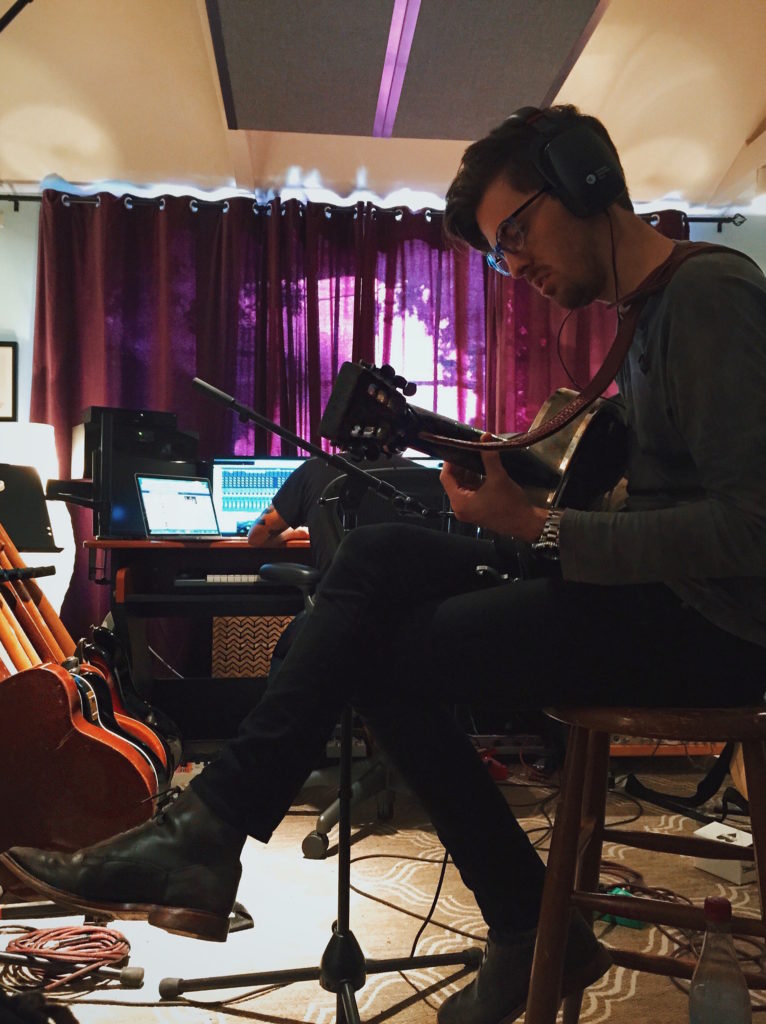
FJ: How did you get started professionally?
MS: I came up to LA and I got hired by an artist up here and signed to a label as a session player and her guitar player and co-wrote a bunch of stuff. A producer in town named Andy Carpenter got me introduced to Mark Phillips, who’s in charge of a lot of the music for a lot of TV shows. This is maybe two years ago, three years ago…
Mark was talking to Andy and said, “I was using John 5 for all these, TV shows and he’s just getting busier and he’s not available.”
And Andy said, “Well, you should use my friend Mason. He’s right down the hall.” So I went and met Mark and we kind of hit it off. I started doing all of the guitar for a lot of these Discovery Channel and History Channel shows: Swamp Pond and Fast and Loud and Pawn Stars… those things. I actually don’t know which shows our stuff ended up making it on. We go in and we record these crazy country songs. If there was a guy in a boat that fell over, I got to do a [sound of guitar] and all these crazy things that go into doing TV sessions.
FJ: Are you looking at a screen with a rough TV edit?
MS: No, they’ll just send us notes like, “We want something that sounds like this.” And… “We don’t want any guitar but we would love some just great, energetic like rock and roll guitar sounds, but without guitar.” What I learned is that when they say they don’t want guitars, we record baritone [guitars]. I have an old Danelectro baritone that you put on there, leave a little bit of treble, leave a little bit of reverb and they’re like, “That’s exactly it! We love that.”
There’s a bunch of tricks to it all, but we don’t actually look at the screen. We just get notes on what they want, the length, where certain breaks have to be. I sit down and we write them and build them up, starting with the Tele usually, and a Dobro or whatever, the usual country things that people want.
Ultimately the thing that they ask for is a particular vibe. If it’s like dark and dusty or if it’s friendly and fun. Words that have nothing to do with guitar. Honestly, it’s kind of fun.
FJ: Is the bulk of your session work these TV soundtracks?
MS: It used to be. Not as much anymore. I started playing with different artists, touring with different artists. Now I rarely have time to hang out with Mark and do those TV tracks. I maybe have done them three times in this last year because I’ve been on the road a lot and doing different sessions… probably even more than TV stuff in the past few years is working with different pedal companies and working with different guitar companies…
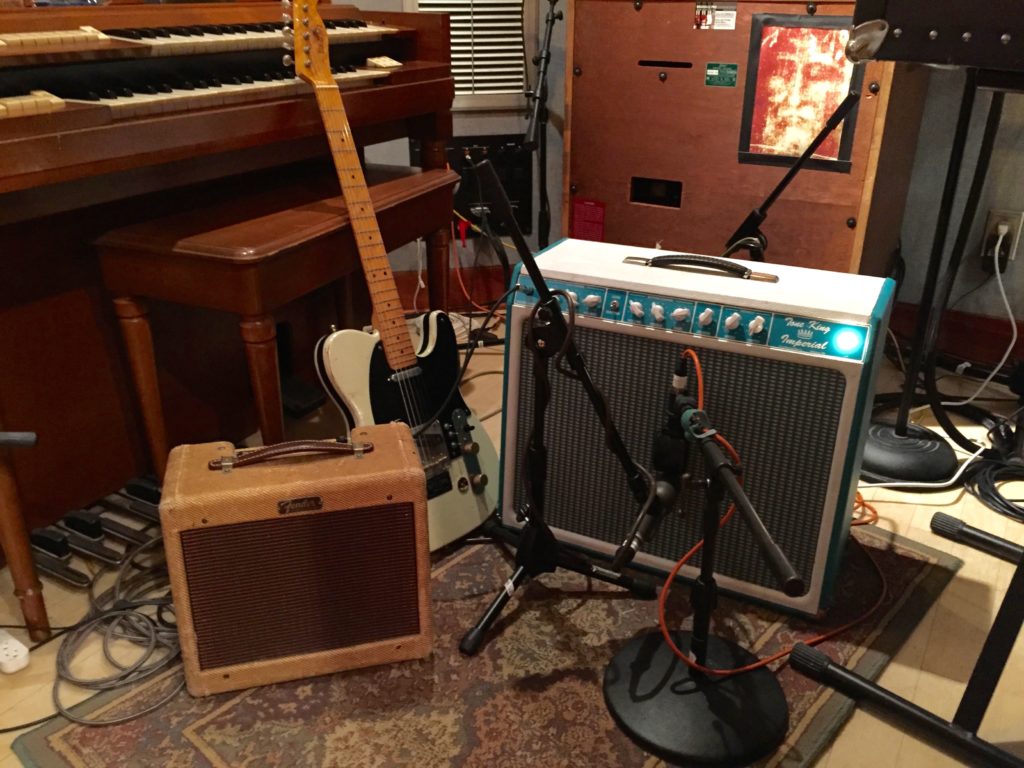
FJ: I was going to ask abou this. Every pedal, amp, guitar company and store now has demo videos. You’ve appeared on a lot of them. Did it all start with one company and now everyone wants you to do one?
MS: Something like that. It was around that time the I left [high school] that I went to NAMM for the first time. I couldn’t believe that I was surrounded by this many people that all love guitar or just love music and love playing it and creating it. So, through NAMM, I just started networking.
One of the first people and companies I worked with was Eastwood guitars. At some point, I contacted [Mike Robinson] their president about getting another guitar from them. He said, “Tell you what: Why don’t you do like a little video with the one you have and then I’ll send you this other one for free?” Holy cow, that sounded great.
I studied film. It was something I knew how to do, so I put this demo together and sent it over to him and he was really into it. He started sending me more guitars and I started doing more videos and then more people started seeing them and contacting me. It started with Eastwood and then it was Moen Guitar Effects and then it was Quilter amplifiers…
I started with just a couple of videos. More and more people started hearing me through them. “Who’s this kid that’s playing this old Chet Atkins stuff?” And I’d say, “It’s me. It’s Mason and here’s my card.”
FJ: Are you a one-stop shop for these videos? Do you play on them, film them and edit them yourself?
MS: I used to be that. I had a couple of good cameras and lighting and but the thing is I really want everything to be great. One Eastwood video would take me a month and I was up there in my bedroom by myself every day with these hot lights on me and running back and forth to the camera. My girlfriend had to help me so much of the time it just got to a point where it just was taking too long.
And so now the way I do them when I do them is kind of a case-by-case basis, depending on who’s calling. If I like the pedal and if it’s something that I want to represent, I’ll get flown in to sit down and do a video. They’ll have a camera crew and they’ll have lighting. Whether it’s for Strymon or Earthquaker or Two Rock amplifiers, Tone King amplifiers, or Fano Guitars, I can just show up and demo there and be in the video.
FJ: Any other projects coming up that you are excited about?
MS: Well, sure. This last year, I’ve been signed full-time to an artist named Brynn Elliot. I’ve been touring and recording with her. She’s an up-and-coming young singer, but she’s been blowing up like crazy and it’s been really exciting to see her grow and see her music get out there. We did a pretty long tour last summer. Came home for a week then flew to Nashville and recorded her full length at Smoakstack, which is Paul Moak’s studio in Nashville, and then went back on tour.
I’m currently doing some stuff with [FJ contributor] Adam Levy, who’s a phenomenal guitar player. Ultimately I’m pushing towards putting out an EP of my own and music of my own in the same way that Blake Mills did with his couple of albums. Blake and I have a lot of the same friends and they were like, “Hey, have you checked out this Blake Mills guy?” Mike Cornwall, who is my guitar tech, has kind of pushed me along the same path, gear-wise as Blake, which has led me to Austen Hooks. I actually owned without knowing it the very first [Filmosound] projector amp he ever made years ago. It’s here. I’m looking at it right now, but I had no idea at the time that that’s what it was.
On tour, I would just stop in every thrift shop I could and look for those projectors. I ended up finding three which at which point I called Austen and said, “Hey, I know you don’t build these for a lot of people and you want to keep it that way, but I went and found three projectors and I only need one.” We talked about it and he had heard of me and was excited to work with me so I said great.
Then this guy Justin Glasco, who is a great producer and drummer said they all started from this guy Reuben [Cox] over at Old Style Guitars. I called Reuben up and he said, “Yeah. The first guy that bought that first one – I don’t remember his name – is some producer. He lives out in West Covina. His name was Hans or something.” I was like, “That’s my guy!”
So then I called Hans and said, “Hey, you still have that amp?”
He said, “Yeah, I have it.”
“Can I have it?”
So now it’s here. I called Austen and told him all that and I’m pretty sure his brain about melted.
FJ: You are one of the most interesting people to follow on Instagram because you are visiting every guitar store of note whenever you’re on the road. For folks who are into gear, it’s pretty awesome to just see someone so enthusiastic and hitting all those stores.
MS: That’s something we haven’t really hit on, and but we probably should… just how obsessed I became with gear.
I just started diving into the history of everything. It’s an obsession. It’s like counting the screw heads on a Strat – a ’54 Strat has 55 screws in the entire body. But if it’s a ’57, you have three more from the new pick guard. So you have 58… There you go. Tell your wife!
That’s part of why the Eastwood videos worked out. On a lot of the videos I was talking about their history and where these guitars came up. I actually kind of ended up digging up a lot of things that I didn’t even know.
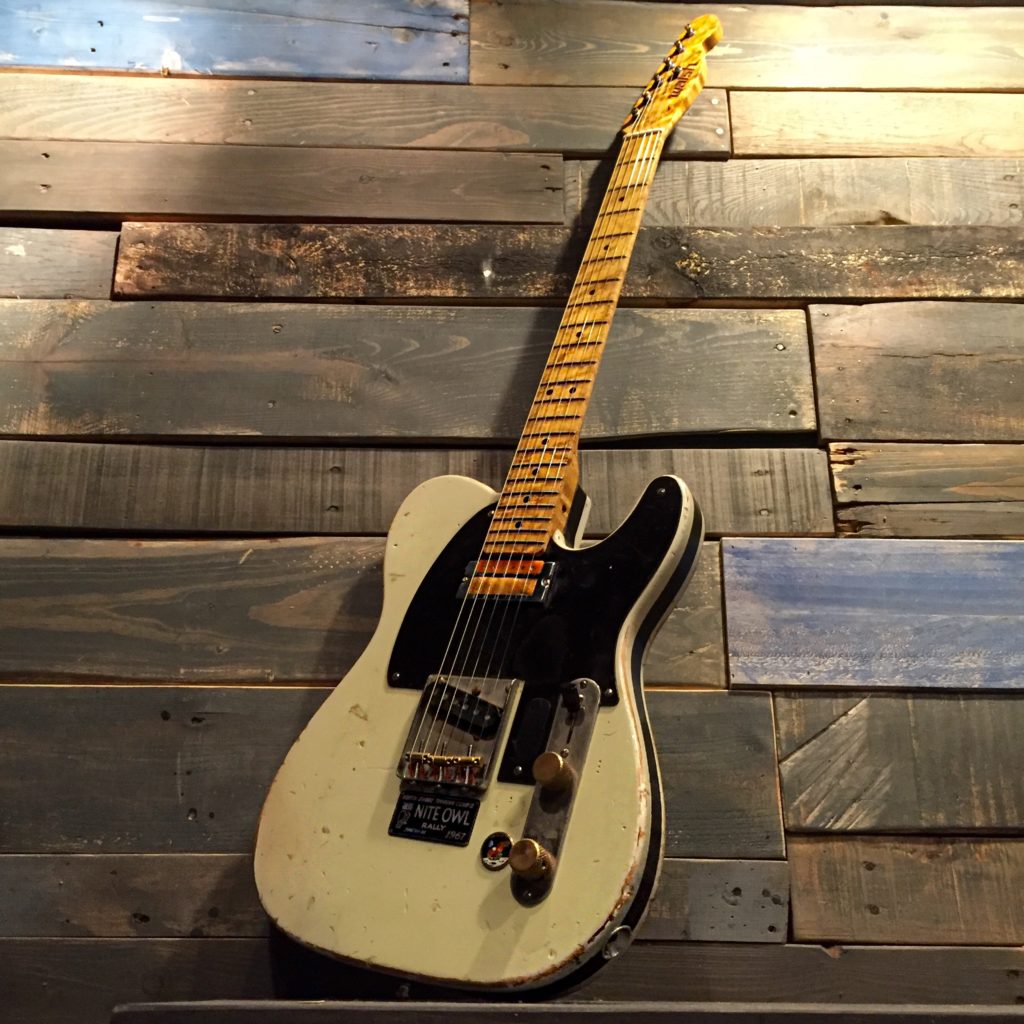
FJ: One of the things we need ask you about is your Telecaster. It’s instantly recognizable. What is its story?
MS: Like I said, I was obsessed with gear and collecting and learning about guitars. I was scrolling through Craigslist every day. There was this builder, Drew Walsh, out in Brea who was putting cool-looking guitars up on Craigslist [that] he was building in his garage. So I contacted him and said, “Hey, I want to come check your stuff out.”
He was building a couple of other guitars he was showing to me, but in the back, he was working on just a white Tele. It was plain, not a relic, nothing special about it. And I kept looking at it and asking, “That’s cool. I’ve never owned a Tele.” He said, “Oh, it’s already spoken for.” I kept bugging him about it. “Please, I will buy that guitar from you.” He kept saying no. Months later, he contacted me and said the guy dropped out. I think I paid $700.00 for it. Within a week, I broke the neck pickup from taking it apart so many times, and I never put it back together for maybe a year. It sat on my floor. I used the body as a base for my drill press. That’s how much I had given up on the guitar.
Once I started getting country gigs it was like, “Man, I need a Telecaster…” I had this one lying around. So I put it back together. The neck’s a little too thin. The finish… man, that finish is super flaky. Drew called me a couple of weeks after I got it and said, “Hey, I think I maybe shot that nitro a little too dry, so if it starts flaking off let me know and I’ll reshoot it.” But, to me, it kind of looks cool.
I put it back together. I made a new pickguard and added a weird pre-amp, had some knobs made, put electrical tape around the side of it to make it look like a cool stripe and it just kind of became this guitar that feels good. I threw in a set of Don Mare Zep-O-Tone pickups. They’re kind of based on Jimmy Page’s Tele and I was super into Jimmy Page at the time…
Somehow, with all these terrible things that it went through it just kind of became this guitar that I learned to trust and I learned to know. It’s been my number one ever since.
This summer I scored a ’53 Tele pickup online. I think I paid $300.00 for it because the guy thought it was out of a Champ lap steel, which it was. But it’s the same pickup. I put that in there and instantly I couldn’t believe how good it sounded. I still had the Don Mare neck pickup, which isn’t bad, but with that ’53 pickup in there it just wasn’t working. I was hanging out with [Mike Cornwall] and he said, “You know what you got to do? You got to throw one of those Guyatones in there.” And I said, “Man, that’s going to look ridiculous. Let’s do it!”
So there, in his backyard with a band saw, we’re cutting this pickguard that I handmade years ago. I slapped a Guyatone in there and it couldn’t sound more perfect. It’s just the most killer freakin’ Tele now. I think that guitar is better known than I am – everybody I know loves it. I have a lot of great guitars and I’m really lucky to have them, but if you have a Tele you trust, you can’t let it go.
I remember one time I was at the movie theater and a song came on and I was like, Man, that guitar sounds really cool. The credits were rolling and it was, “Oh, wait; that’s me. That’s my guitar.”

Photo Credit: Shelby Pollard at Chicago Music Exchange
FJ: And you just got a ’52 Tele… what’s the story there?
MS: I bought it from a collector named Andre Mattos in Australia, who had bought it from the original owner in Texas who had not so wisely painted the whole guitar with white automobile primer, played the shit out of it, and then left it out in a barn for the next 45 years or so.
After Andre bought it from him, he sent it to Chad at CF Restorations to have its finish restored and neck refretted. After Chad stripped the primer off the body and neck, he was able to uncover the guitar’s original dates and signature – the body was built on 12/4/52 and the neck on 12/24/52 (both built and signed by Tadeo Gomez), making it one of the last Telecasters built that year.
When I was younger, I’d go to the Fender Museum in Fullerton after school almost every day just to stare at Roy Buchanan’s 1953 “Nancy” Telecaster behind the glass. It’s always been a dream of mine to own an original Blackguard, though I never thought that day would actually come. I just got insanely lucky to have met Andre – he wanted to see his Tele get back in the hands of a musician instead of the vault of a collector. With his patience and flexibility, as well as some serious help from my buddy Trevor Boone at Emerald City Guitars, Andre and I made the deal.
I was still in the middle of a tour with Brynn Elliott and Grace Potter, but I knew we would have some time off in Chicago, which is coincidentally very close to where Chad is based. So I had the Tele shipped to Chad, who put the guitar back together and set it up with a set of 12s Gabriel at the Gabriel Tenorio String Co. had hand-wound and overnighted.
On the day the band and I finally did get into town (which was on my birthday, conveniently enough), Chad and I figured there wasn’t a better place to meet up than Chicago Music Exchange. I picked the guitar up, bought Chad the biggest beer I could find and then immediately hit the road again to use it onstage every night for our remaining shows with the Lone Bellow.
It really is a magical guitar, man. I’m still in shock I actually own the thing, but I can’t wait for the lifetime of recording and touring we’ll be doing together from here on.
![dawb-six_that_get_you-600x600[1]-3](https://www.fretboardjournal.com/wp-content/uploads/2016/07/dawb-six_that_get_you-600x6001-3.jpg)
